Deciduous Tree Catalog
Contact the office for a current pricelist
Sales open in January and run through March
The tree supply is limited so make sure to purchase early
Deciduous trees are those that lose their leaves annually, typically in the fall, before entering a dormant winter period. They contrast with evergreen trees, which retain their foliage year-round. One of the spectacular things about shade trees is the wide array of colors that their leaves display before they are shed. This leaf shedding is a survival mechanism, allowing the tree to conserve energy during colder or drier seasons. Deciduous trees, such as oaks and maples, have broad, flat leaves that change color and fall off annually, and they reproduce via flowers that develop into fruits or nuts.
American Elm Tree
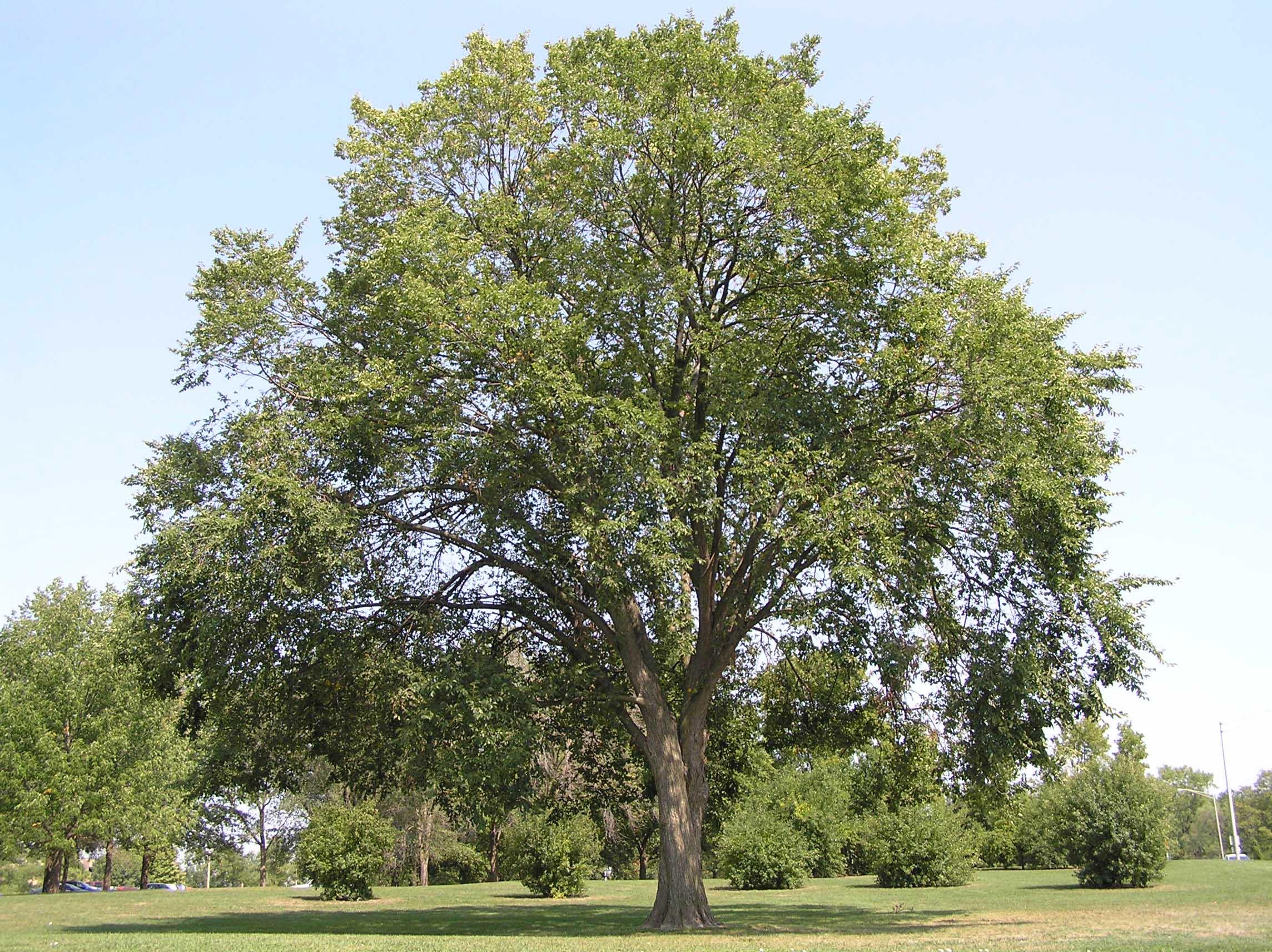
Ulmus americana
- Leaves & Flowers
Insignificant small green flowers that bloom in early spring give way to samaras (double winged seeds). This tree has a broad rounded shape with spreading, slightly drooping, branches
- Fruits:
Both the samara and the fallen seed are edible. According to Thayer (2006), the samara is best eaten as soon as it appears while still fully green on the tree
- Growth Habit & Hardiness
- American elm is a rapidly growing perennial, woody, deciduous tree in the elm family (Ulmaceae). It grows 60 to 80 feet tall with a trunk diameter of 2 to 5 feet. Older trees sometimes develop buttresses that expand their base. American Elm trees are native to eastern and central North America, primarily in the United States, and extending into southern Canada. They thrive in moist, deep, rich soils and are often found on stream banks, floodplains, and other moist areas.
- Fall Color:
In the fall, leaves turn a golden yellow.
- Wildlife Value:
The fruits are a favorite food source for birds, and the trees provide shelter and food for other wildlife.
Black Walnut Tree
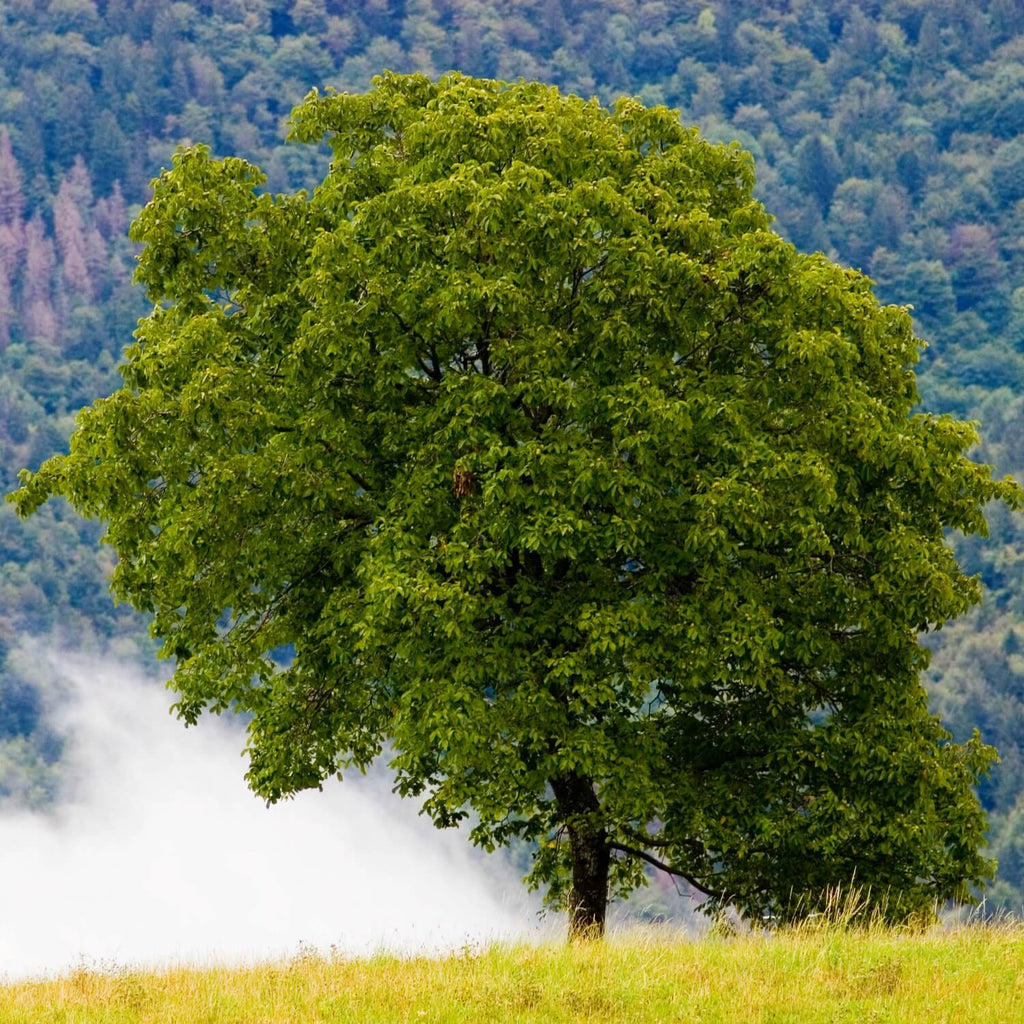
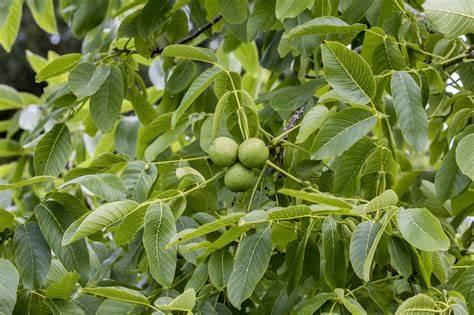
Juglans nigra
commonly called Green Black Walnut, Green Walnut,
- Leaves & Flowers
This a large deciduous tree typically growing 75-100’ (less frequently to 125’) tall with and an oval to rounded crown. This tree features pinnately compound, alternate leaves that are 12–24" in length and consist of 15–23 dark green leaflets that are 2–5" long; the leaflets are finely toothed
- Fruits:
The nuts are edible and also pack plenty of vitamin A, iron, minerals, and fiber. May be grown for its edible nuts. Although young trees will sometimes begin producing nuts when only 4-6 years old, it usually takes 12-15 years before a tree will produce a large crop of nuts.
- Fall Color:
Black Walnuts have ordinary non vibrant yellow leaves in the fall.
- Growth Habit & Hardiness
- native to central and eastern North America, growing mostly in riparian zones. Black walnut is susceptible to thousand cankers disease, which provoked a decline of walnut trees in some regions.
Prefers moist, organically rich, well-drained soils in full sun. Intolerant of shade. Difficult to transplant because of deep taproot.
This tree is remarkable for its leaves that emerge green and mature to dark purple as the weather warms. Foliage color intensifies to reddish purple in autumn.
- Wildlife Value:
Black Walnut is a food source for many animals and birds.
Bur Oak Tree
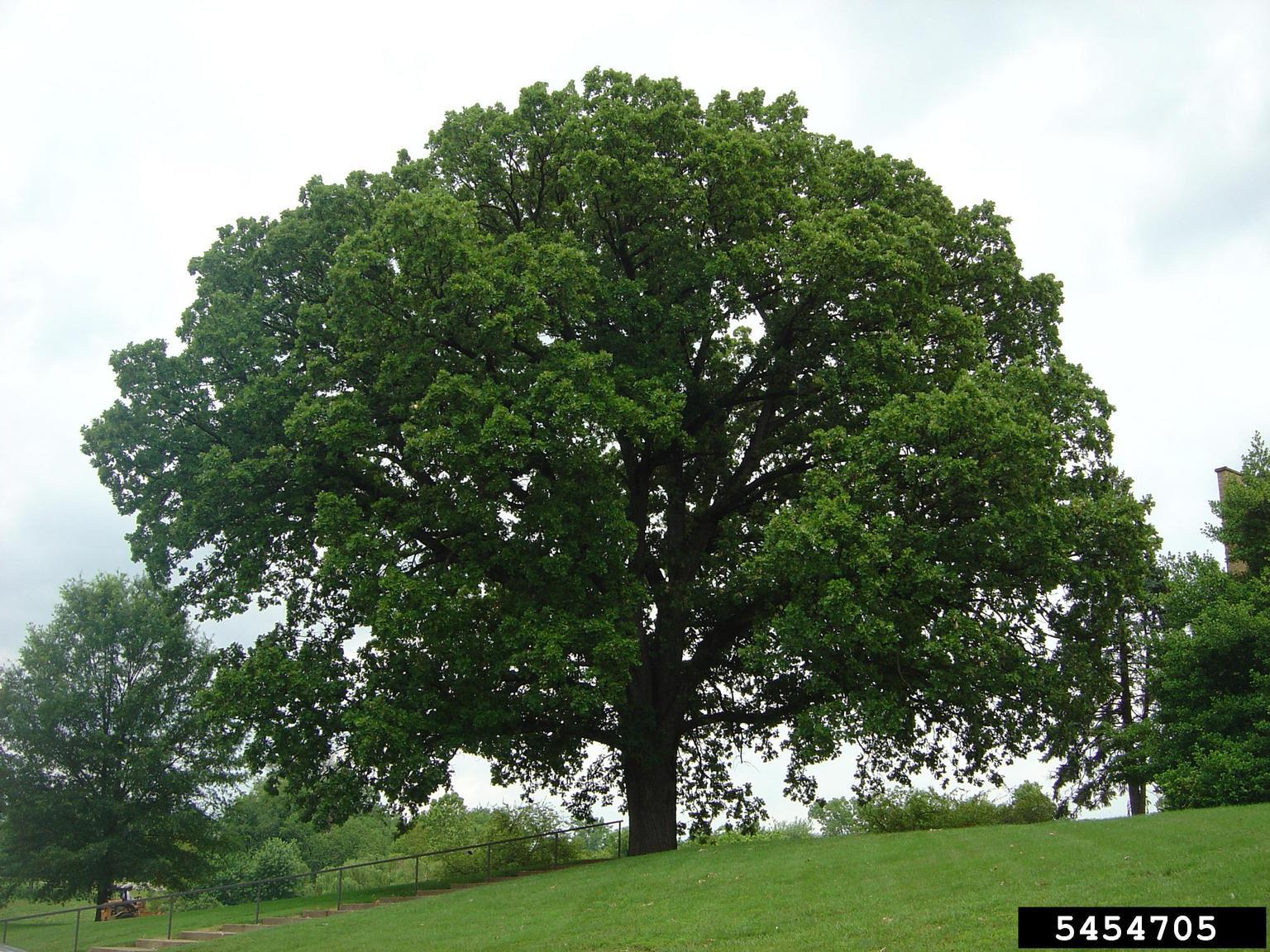
Quercus macrocarpa or Mossy Cup Oak
- Leaves & Flowers
A coarsely textured crown and a massive trunk with rough and deeply furrowed bark combine to make one impressive tree. They have long thin leaves with deep, rounded variegated edges.
- Fruits:
It grows wild and wooly acorns
- Growth Habit & Hardiness
The Bur Oak is a popular choice for Colorado landscapes due to its adaptability, ruggedness, and tolerance of urban environments. It's often planted as a shade tree, thriving in Colorado's climate and soil conditions, and is also relatively pest-free. It's considered a hardy and long-lived tree, reaching mature heights of 50-70 feet with a broad canopy. They can live for 300 years or more.
- Fall Color:
Fall color is usually yellow turning to brown, but sometimes red.
- Wildlife Value:
The Bur Oak produces acorns that are popular with wildlife. This is slow growing, but long lived. It grows thick, strong branches that provide shade and shelter for wildlife.
Bur Gamble Oak
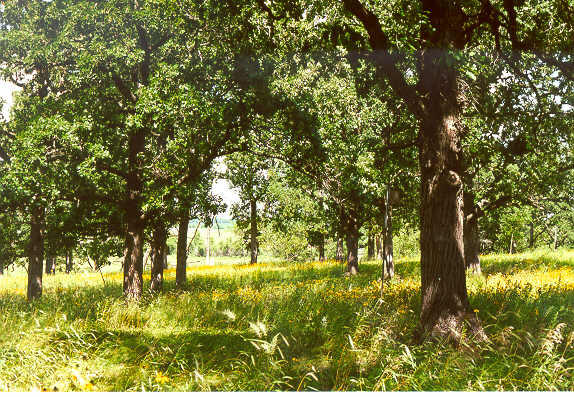
Quercus macrocarpa
- Leaves & Flowers
A coarsely textured crown and a massive trunk with rough and deeply furrowed bark combine to make one impressive tree. They have long thin leaves with deep, rounded variegated edges.
- Fruits:
It grows wild and wooly acorns
- Growth Habit & Hardiness
Is a long-lived tree that tolerates pollution and heat stress. They offer dense shade and the prefer moist, well drained, loamy soil. They are generally hardy and drought-tolerant, making them suitable for various conditions. They tend to form dense thickets on dry canyon slopes, but in meadows may be spaced more generously apart
- Fall Color:
Gambel oak really stands out with its magnificent array of leaves in red, orange, yellow and gold.
- Wildlife Value:
The Bur Gamble Oak produces acorns that are popular with wildlife. Colorado state butterfly, the Colorado hairstreak. This butterfly spends its entire life within thickets of Gambel oak. The larvae can eat only Gambel oak leaves.
Chokecherry Tree
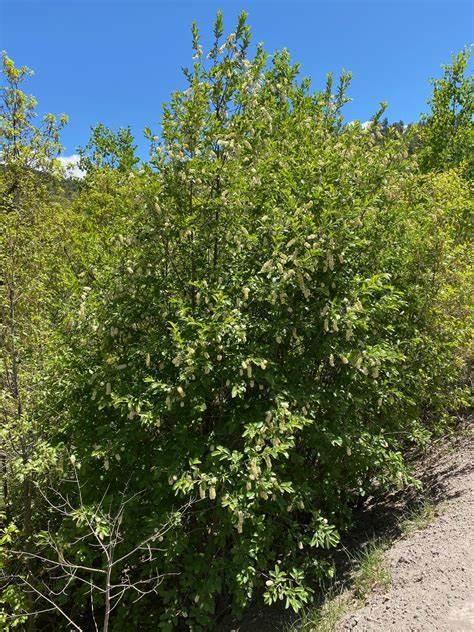
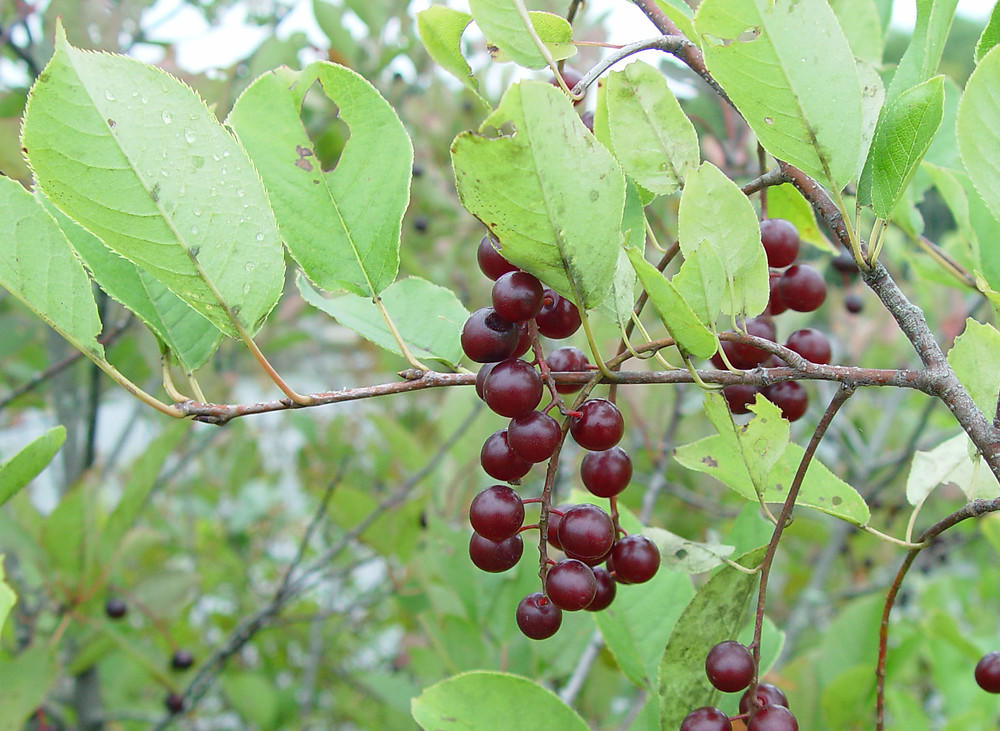
Prunus virginiana
commonly called bitter-berry, chokecherry, Virginia bird cherry, and western chokecherry
- Leaves & Flowers
The slender brown twigs also have an unpleasant odor and a bitter taste as well. The bark is brown or gray, smooth on new growth but becoming scaly with age.
Chokecherries produce hanging spikes of off scented white flowers.
- Fruits:
The astringent fruits range in color from red to black. The tart, edible fruits are grown in clusters and range in color from red to black and are also used in jelly, syrup, and wine.
- Growth Habit & Hardiness
- The plant grows to a height of 20 feet and is a very cold hardy tree. Chokecherries often form dense thickets on moist soils.
- Fall Color:
This tree is remarkable for its leaves that emerge green and mature to dark purple as the weather warms. Foliage color intensifies to reddish purple in autumn.
- Wildlife Value:
Chokecherry is a food source for many animals and birds.
Hackberry Tree
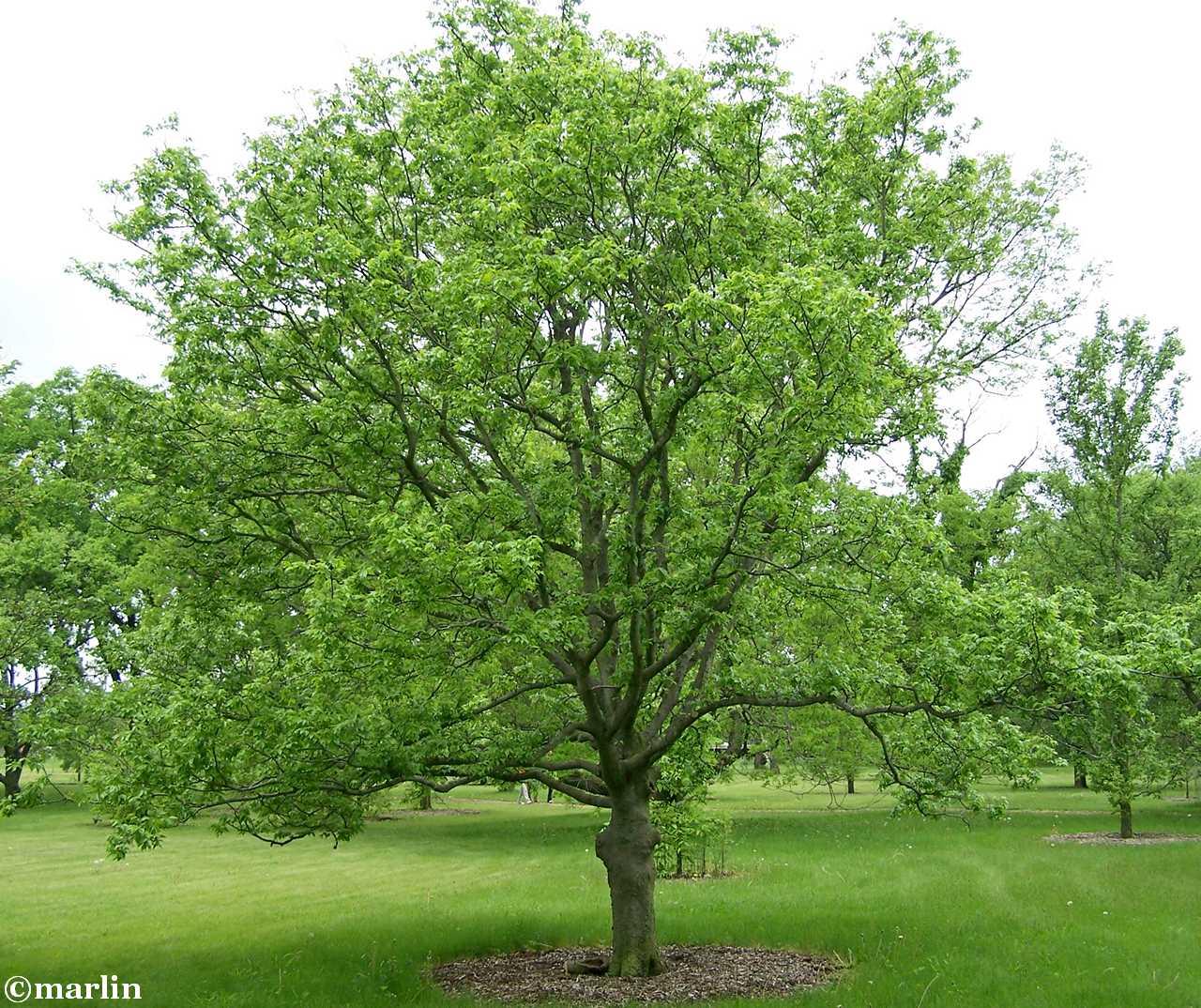
Celtis occidentalis L. (Ulmaceae)
Although common hackberry and sugarberry
- Leaves & Flowers
Leaves are alternate, simple, with one side longer or wider than the other, sharply toothed, 2–4 inches long, with 3 main veins emerging from the base, tip sharply pointed, base uneven.
- Fruits:
Hackberry trees produce small, edible fruit that ripens in late summer and fall, turning from orange-red to dark purple.
- Growth Habit & Hardiness
- Hackberry prefers a deep moist soil, but is drought resistant on upland sites. On favorable soils it may reach a height of 60 to 70 feet. Growth is slow at first, but after a few years should average 12 to 18 inches annually.
As landscape plants, hackberries are not without other problems. They're messier than most other trees, tend to be short-lived, are prone to breaking in storms and don't often make particularly handsome specimens.
- Fall Color:
The leaves turn yellow in the fall, often among the first trees to show color.
- Wildlife Value:
Hackberries are extremely important sources of food for wildlife.
Hardy Apricot Tree
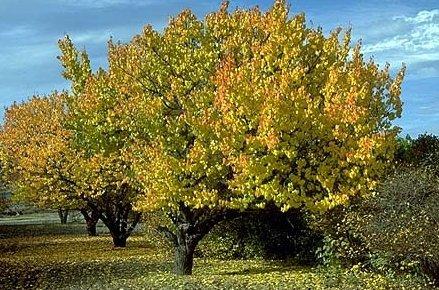
Prunus armeniaca
- Leaves & Flowers
Apricots are fine, ornamental small trees with an early spring bloom. White to pink flowers appear in May followed by the small edible fruit which ripens in July and August.
- Fruits:
Self pollinating, though will produce best when in presence of other species in the Prunus genus, such as wild black cherry, choke cherry, and American Plum. The fruit is similar to a small peach. The flesh is usually firm and not very juicy. Its taste can range between sweet to tart. The fruits can be used for jams, jellies and dried snacks.
- Growth Habit & Hardiness
It is a small tree, 26–39 ft tall. They prefer a well-drained soil. Apricots grow well in mild climates with long summers. The tree will thrive protected from wind that still receives full sunlight. A healthy apricot tree can live from 20 to 30 years.
- Fall Color:
Hardy apricot trees, like the Manchurian apricot, typically display a golden orange to yellow fall color. Some varieties, like Casino Apricot, also show a yellow fall foliage. This vibrant color makes them attractive ornamental trees, especially during the autumn season
- Wildlife Value:
After the matured fruit drops to the ground , large field mice, squirrels and other small rodents enjoy the nutritious flesh and seeds it contains.
Honeylocust Tree
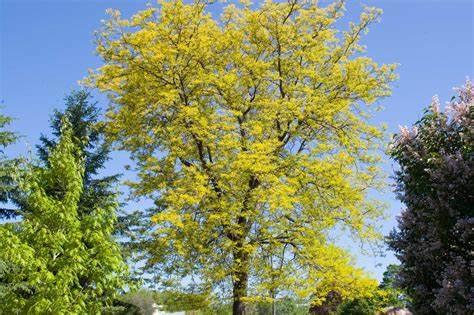
Gleditsia triacanthos
- Leaves & Flowers
The trunk and branches have stout thorns (up to 3 inches long) that have one or three branches. The tree also drops large seed pods. The leaves of the tree are pinnately compound. Each leaflet is vibrant green in color. Honey locusts have small, off-white, male and female flowers on separate trees that emerge in late spring.
- Fruits:
None
- Growth Habit & Hardiness
Honey locust is a rapidly growing, large deciduous tree. This tree can grow up to 80 feet tall with a single trunk 2 to 3 feet in diameter and a broad, flat-topped crown, casting light shade that allows turf grass to grow underneath. Plant it in full sun and in well-drained, moist soil high in organic matter. It will tolerate partial shade but does not grow in full shade. It also tolerates a wide variety of soil types and moisture conditions. Propagation is through seed or stem cutting. This tree is highly salt, wind and drought tolerant once established and resistant to damage by deer and pollution.
- Fall Color:
In the fall, these leaves turn a range of vibrant yellows.
- Wildlife Value:
The pulp inside the seed pod is edible which makes the tree an attractant for bees, moths, butterflies, and small mammals. It is the host plant for the larvae of the Silver-spotted skipper (Epargyreus clarus) moth.
Look for thornless varieties like Gleditsia trianthos var. inermis or thornless and podless cultivars like 'Sunburst.'
Native Cottonwood
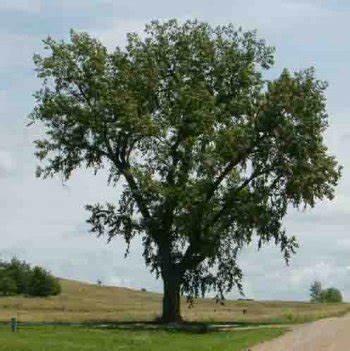
Populus deltoides
Native cottonwood trees, like Eastern cottonwood, Fremont cottonwood, and Black cottonwood
- Leaves & Flowers
Cottonwood trees have distinctively shaped leaves that are generally broad, triangular, and alternate along the branches. These leaves are typically dark green on the top surface and lighter green underneath. They are characterized by a flattened petiole (leaf stalk) which allows them to flutter in the wind, and they often have coarse teeth along the edges
- Fruits:
These trees do not bear edible fruit or nuts. These trees are also characterized by their cottony seeds, which are released in the spring
- Growth Habit & Hardiness
Native Cottonwoods are fast-growing, large-canopied trees native to North America. They are known for their rapid growth, often reaching heights of 100 feet or more. Rapid growth, though short-lived as specimen trees. Tolerant of any (except for constantly waterlogged) soil, does best in deep, fertile, moist but well-drained soil. Weak wood and brittle limbs create wind and ice problems for this fast grower. Susceptible to a number of cankers and borers. Female trees produce clouds of cottony seeds each spring that can be a temporary nuisance. Roots can be invasive. Adapts to a variety of soils. Shade tree, Fall conspicuous, Fast growing, Easily grown.
- Fall Color:
The tree offers strong fall color, with leaves fading to glowing shades of gold.
- Wildlife Value:
This tree attracts: Birds , Butterflies, Mourning Cloak, Red-spotted Purple, Viceroy & Tiger Swallowtail butterfies.
Quaking Aspen
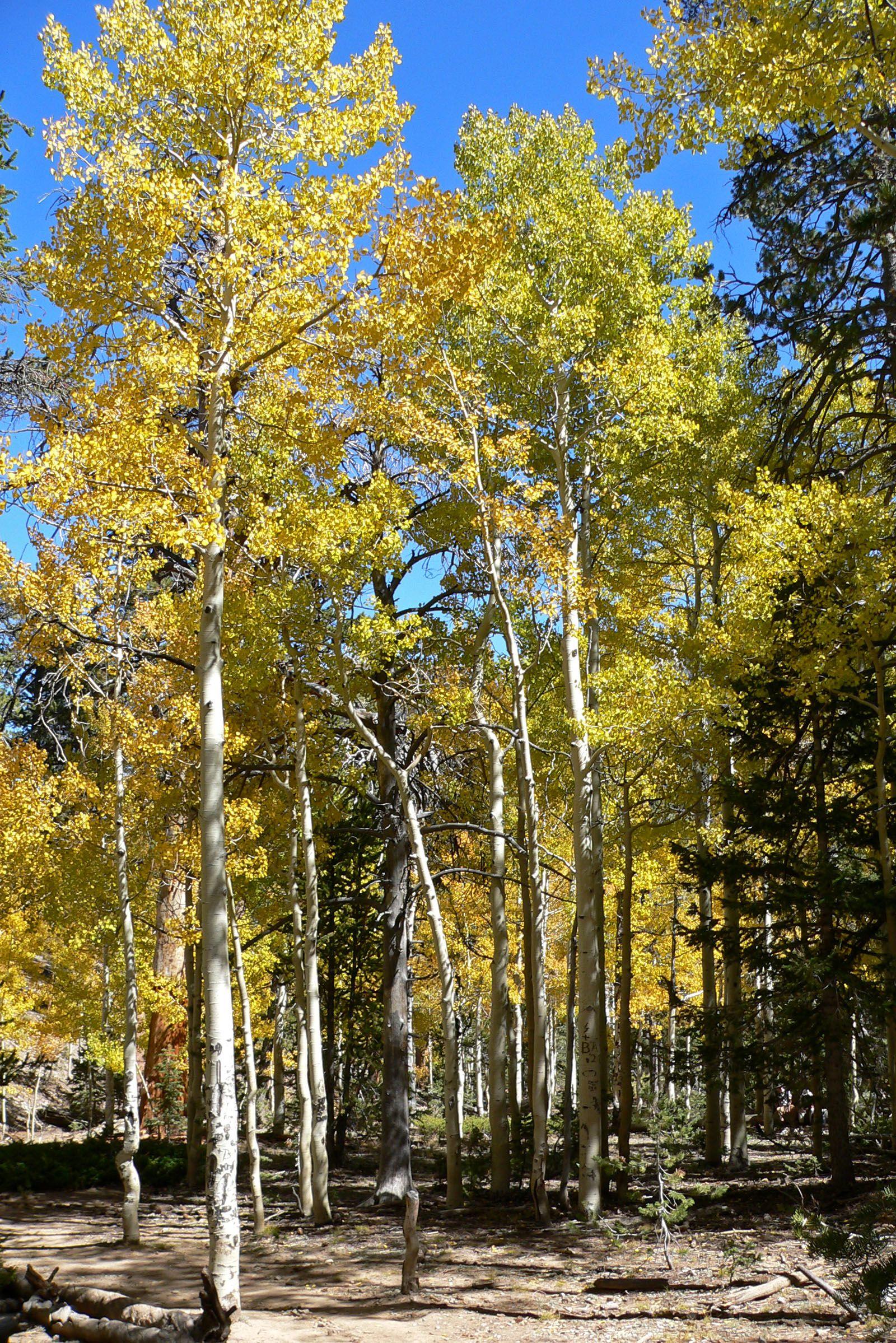
Populus tremuloides
Trembling aspen, American aspen, mountain or golden aspen, trembling poplar, white poplar, and popple, as well as others.
- Leaves & Flowers
Its small, nearly round, shiny leaves have a flattened petiole which allows them to quiver in the slightest breeze. Smooth, whitish-green bark becomes furrowed at the trunk’s base with age. Silvery catkins appear before leaves.
- Fruits:
These trees do not bear edible fruit or nuts.
- Growth Habit & Hardiness
Quaking aspen reproduces rapidly from seed and root suckers. It is short-lived and plagued by disease and insect problems, but is practically indifferent to soil conditions. In any soil, weeding around the tree can boost its growth surprisingly. Aspen can be grown in a clump by periodically removing the older, damaged stems, allowing new sprouts to fill in.
- Fall Color:
Fall colors are bright yellow to gold.
- Wildlife Value:
The twigs and foliage are browsed by deer, elk, and moose, also by sheep and goats. Beavers, rabbits, and other mammals eat the bark, foliage, and buds, and grouse and quail feed on the winter buds.
Russian Olive
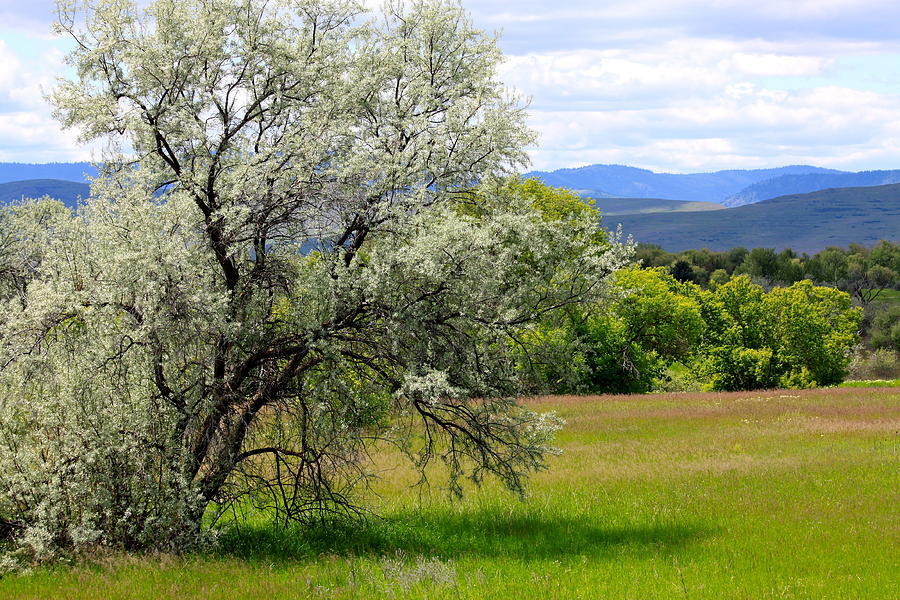
Elaeagnus angustifolia
- Leaves & Flowers
The plant has olive-shaped fruits, which are silvery at first, then yellow-red when mature, Leaves are 2 to 3 inches long, alternate, narrow, and have simple blades with smooth edges. The leaf’s lower surface is silvery-white, while the upper surface is light green. Flowers are four small sepals in light yellow clusters that are fragrant and appear May through June.
- Fruits:
Nonedible fruits mature from September to November.
- Growth Habit & Hardiness
Russian olive is a perennial tree or shrub native to Europe and Asia. . Russian olive can reproduce by seed or root suckers. Birds readily spread seeds and can remain viable for up to 3 years. Spring moisture and slightly alkaline soil tend to favor seedling growth. The plant’s extensive root system sprouts root suckers frequently. The tree can reach up to 30 feet with branches with 1 to 2-inch thorns. Russian olive twigs are flexible, reddish, and have surfaces coated with gray and scaly pubescence, becoming smooth.
It grows relatively quickly and develops a dense canopy which crowds out vegetation or prevents shade-intolerant vegetation from establishing, thereby reducing species diversity and plant productivity.
- Fall Color:
Russian Olives typically display a muted yellow to orange color in their fruit, which are small, elliptical, and mealy. The leaves also turn from their typical silvery-green to a muted yellow before dropping.
- Wildlife Value:
Birds and other animals such as coyotes, deer, racoons, and small mammals consume the fruit.
Sand Cherry
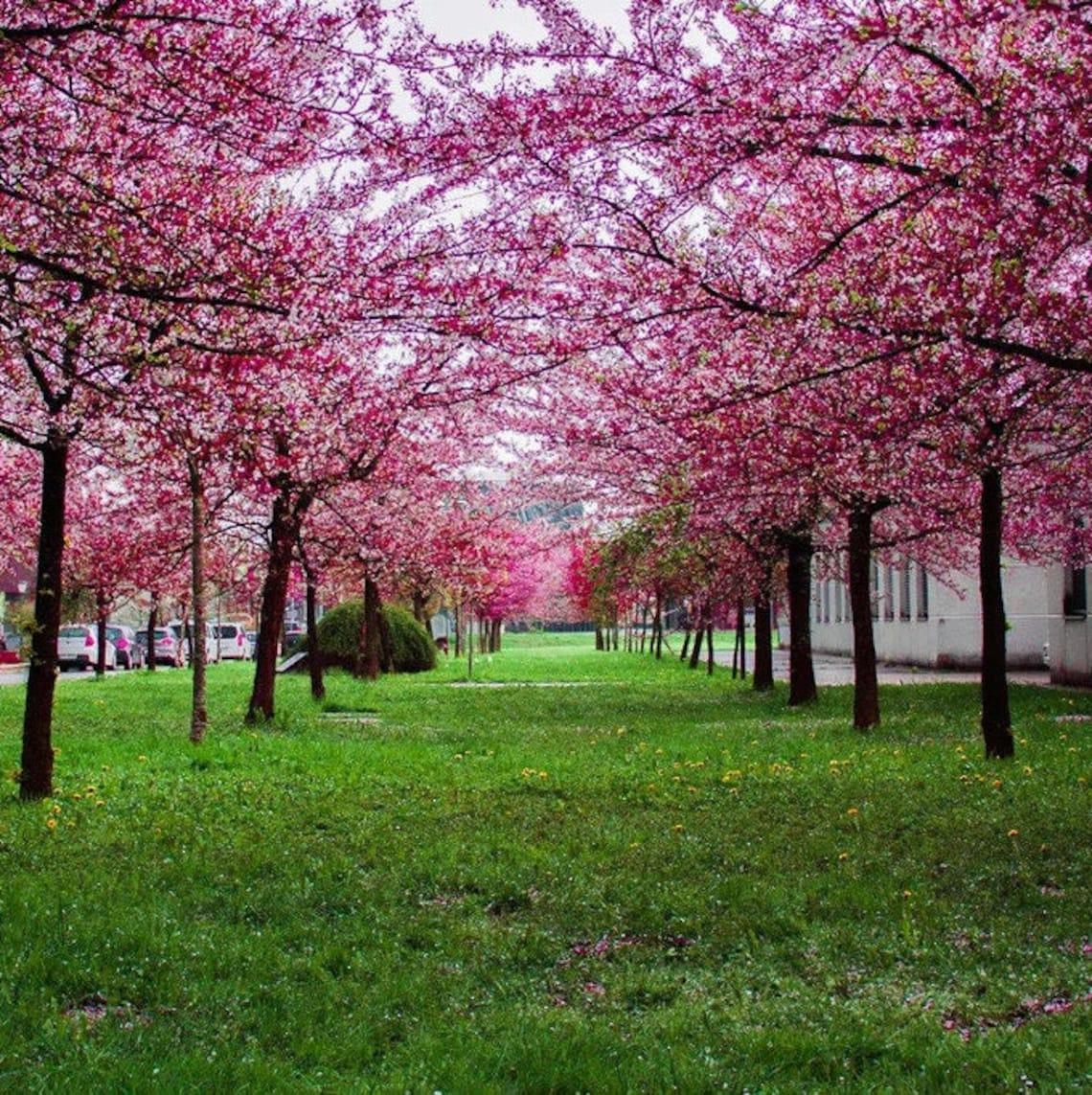
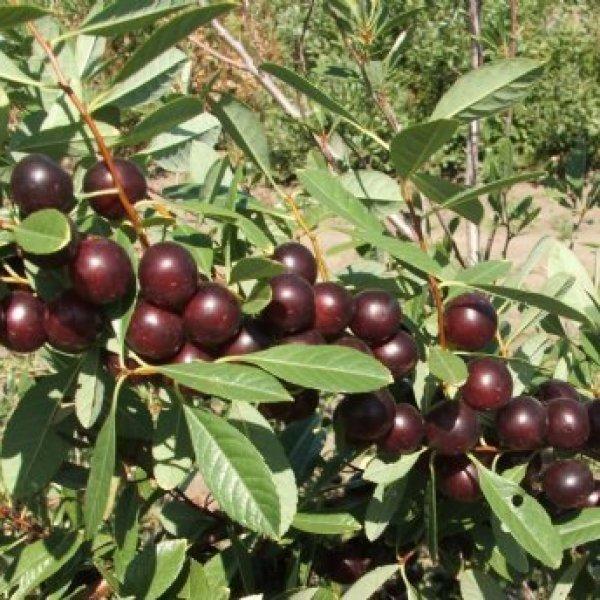
Prunus x cistena
- Leaves & Flowers
It produces fragrant light pink to white flowers from late April to early May. Features simple leaves with an intense reddish-purple coloring that lasts all summer
- Fruits:
Yields small, sour fruit that is blackish-purple in color and sparse in quantity. While there will never be a large cherry crop, the fruit is commonly used for making jams, jellies, and pie.
- Fall Color:
The mix of fall colors becomes a riotous mixture of yellow, orange, and red!
- Growth Habit & Hardiness
This tree tolerates many soils, grows in a rounded shape and it is winter-hardy. This is a very hardy flowering landscape specimen with reddish-purple foliage that keeps its unique color all summer. Because of this, the purple leaf sand cherry makes an excellent contrast tree. It can be planted close to paved surfaces and near utility lines and can also be used as a deciduous hedge.
- Wildlife Value:
This tree is an important source of food for many small birds and mammals including robins, cardinals and coyotes. Birds nest in its branches.
CAUTION: All parts of this tree, except the flesh and the skin of the cherries, contains the toxin hydrocyanic acid ( Kershaw). This is toxic to animals and people.